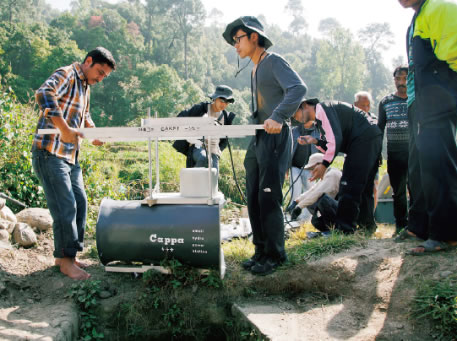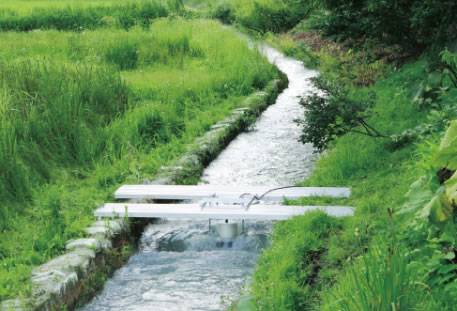Master Techniques from Japan to the World 5
Bringing Light to Regions without
Electricity in Nepal
– The challenge of “Cappa,” a small hydro-kinetic power generator
that can be carried by just two people

The small hydro-kinetic power generator “Cappa” which can be carried by two adults by hand (Photo: ibasei)

Mr. Norio Kikuchi explains about the “Cappa” to Nepalese government officials and general public. (Photo: ibasei)

The “Cappa,” hydro-kinetic -power generator, in operation (Photo: ibasei)
Nepal is a country with a rich natural environment, surrounded by mountains that soar above 8,000 m, and visited by many overseas tourists and mountaineers. The precipitous topography of the Himalayan mountain range and its rich water resources lend themselves well to hydroelectric power generation which is Nepal’s main source of power. However, at peak times power demand outstrips supply and in urban areas it is not unusual for planned load shedding to last for more than 10 hours each day. The electrification rate of rural areas is also very low and there are still many regions that do not enjoy the freedom to use electricity that is essential for so many aspects of daily life.
Following the Great East Japan Earthquake in 2011 there was an increased interest in independent power supply systems that are resilient in natural disasters and emergencies and also in natural forms of renewable energy. In response, ibasei, Ltd., a company headquartered in Hitachi City, Ibaraki Prefecture launched a project to develop a small hydro-kinetic power generator. After two years of efforts the company succeeded in creating “Cappa,” a lightweight hydro-kinetic power generator. Hoping to use Cappa to bring light to developing countries, and as a result of a survey in various regions in Asia, the company decided on Nepal as the country to launch the project. With its compact design (the main unit weighs 57 kg) Cappa can be carried by two adults, meaning it can be easily installed even in mountainous regions that are difficult to access. Cappa is unlike many small hydro-kinetic power generators that require water to fall vertically down from an upper to lower elevation in order to generate power. Instead, Cappa utilizes the latest Formula One and aircraft technologies and its defining characteristic is that it is capable of generating power stably 24 hours a day, simply by laying it in the flow of a river or other water channel. One of the reasons why “ibasei” chose Nepal was also thanks to the prevalence of natural water flows. Looking back on the project, “ibasei” President Mr. Norio Kikuchi puts it this way, “There are many small rural villages dotted around the Himalayas and our idea was that these villages could install and operate Cappa simply, and use it in a way that matched the individual needs.”
In 2014, under JICA’s Partnership with Japanese SMEs for the Private Sector for Utilizing Japanese Technologies in ODA Project,1 “ibasei” applied for a Feasibility Survey.2 In February 2015 the Feasibility Survey was accepted and from June, a one-year survey began to assess the potential for Cappa in Nepal, as well as anticipated challenges and compatibility with local conditions. The survey included assessments of water flows and the surrounding environment at candidate locations for the project site, as well as a survey by hearing. A Cappa unit was also brought in and a demonstration was implemented. When local residents and local government representatives saw a lightbulb lighting up, they all gave a big round of applause and the survey team received comments such as, “We want to use Cappa straight away,” and “I would like you to install Cappa in other remote regions of the Himalayas.” Mr. Kikuchi and his team heard from the people of Nepal how just a small light could bring comfort and transform lives.
In order to assess whether it would be possible for the maintenance of Cappa units and the production of some components to be done locally, “ibasei” also visited the Nepal Micro Hydro Power Development Association (NMHDA) and local manufacturers and surveyed them. These visits and the survey resulted in a big interest in producing and assembling Cappa components and joint management with a Japanese company, among the visited places.
Mr. Kikuchi says, “Initially I thought that it would be only the rural villages without electrification that would need electric power, but through the survey I realized that there were also needs in urban areas, including schools and medical facilities.”
Based on the results of the Feasibility Survey, “ibasei” is planning to conduct a Verification Survey3 from April 2017 to March 2019 in pilot sites in the Kathmandu and Kaski Districts to prove the effectiveness of Cappa (plan as of September 2016). For the Verification Survey a Cappa unit and a low-drop small hydro-kinetic power generator will be installed in an area with unstable power supply and an area that is not currently electrified. The plan is to help to improve living standards and the educational environment by supplying power to schools and the surrounding communities.
In terms of future objectives, Mr. Kikuchi has this to say, “If we are able to transfer part of the manufacturing process to a local manufacturer and establish a production system, it would boost the cost competitiveness of the product, and would also help to create employment and industry in Nepal. We are also aiming to work with the people in Nepal to develop ways to use Cappa that match local needs.”
*1 Projects aiming to achieve both the development of developing countries and the activation of the Japanese economy by utilizing Japanese SMEs’ excellent products and technologies through ODA.
*2 A survey on the feasibility of using a certain product or technology for the development of a developing country based on a proposal from a Japanese SME.
*3 A survey to verify ways to enhance a product and technology’s compatibility with a developing country and thereby disseminate the product and technology, based on a proposal from a Japanese SME.
<< Previous Page Next Page >>
Main Text | Statistics and Reference Materials | Stories from the Field | Master Techniques from Japan to the World | ODA Topics
